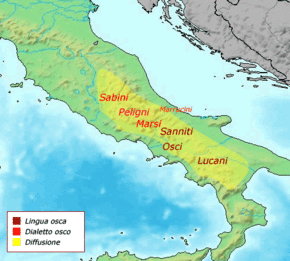Oscan language
Oscan was spoken by a number of tribes, including the Samnites,[3] the Lucani, the Aurunci (Ausones), and the Sidicini.
The Oscan group is part of the Osco-Umbrian or Sabellic family, and includes the Oscan language and three variants (Hernican, Marrucinian and Paelignian) known only from inscriptions left by the Hernici, Marrucini and Paeligni, minor tribes of eastern central Italy.
In Apulia, there is evidence that ancient currency was inscribed in Oscan (dating to before 300 BCE)[6] at Teanum Apulum.
[7] Oscan graffiti on the walls of Pompeii indicate its persistence in at least one urban environment well into the 1st century of the common era.
[9] In coastal zones of Southern Italy, Oscan is thought to have survived three centuries of bilingualism with Greek between 400 and 100 BCE, making it "an unusual case of stable societal bilingualism" wherein neither language became dominant or caused the death of the other; however, over the course of the Roman period, both Oscan and Greek were progressively effaced from Southern Italy, excepting the controversial possibility of Griko representing a continuation of ancient dialects of Greek.
[10] Graffiti in towns across the Oscan speech area indicate it remained in colloquial usage.
[16] Some Oscan graffiti exists from the 1st century CE, but it is rare to find evidence from Italy of Latin-speaking Roman citizens representing themselves as having non–Latin-speaking ancestors.
For example, the Garigliano Bowl was found close to Minturnae, less than 40 kilometers from Capua, which was once a large Oscan settlement.
For example, Latin volo, velle, volui, and other such forms from the Proto-Indo-European root *welh₁- ('to will') were represented by words derived from *ǵʰer- ('to desire'): Oscan herest ('(s)he shall want, (s)he shall desire', German cognate 'begehren', Dutch 'begeren', English cognate 'yearn') as opposed to Latin volent (id.).
At the beginning of the 3rd century BCE its sign inventory was extended over the classical Etruscan alphabet by the introduction of lowered variants of I and U, transcribed as Í and Ú. Ú came to be used to represent Oscan /o/, while U was used for /u/ as well as historical long */oː/, which had undergone a sound shift in Oscan to become ~[uː].
[28] Short e "generally remains unchanged;" before a labial in a medial syllable, it becomes u or i, and before another vowel, e raises to higher-mid [ẹ], written í.
[29] Long ē similarly raises to higher-mid [ẹ], the sound of written í or íí.
[40] Oscan nouns can have one of the seven cases: nominative, vocative, accusative, genitive, dative, ablative and locative (the latter is not present in Latin).
[45] Other tenses are formed by suffixation:[46] The following non-finite forms are attested (all of them are based on the present stem):[47] Ekkum svaí píd herieset trííbarak avúm tereí púd liímítúm pernúm púís herekleís fíísnú mefiú íst, ehtrad feíhúss pús herekleís fíísnam amfret, pert víam pússt íst paí íp íst, pústin slagím senateís suveís tanginúd tríbarakavúm líkítud.
avt anter slagím abellanam íním núvlanam súllad víú uruvú íst.
Suae pis pertemust, pruter pan … (5) deiuatud sipus comenei, perum dolum malum, siom ioc comono mais egmas touti- (6)cas amnud pan pieisum brateis auti cadeis amnud; inim idic siom dat senates (7) tanginud maimas carneis pertumum.
[48]In Latin: (3) … iurabit maximae partis senatus sententia [dummodo non minus] (4) XL adsint, cum ea res consulta erit.
Si quis peremerit, prius quam peremerit, (5) iurato sciens in committio sine dolo malo, se ea comitia magis rei publicae causa, (6) quam cuiuspiam gratiae aut inimicitiae causa; idque se de senatus (7) sententia maximae partis perimere.
[49] Notes: Oscan carn- “part, piece” is related to Latin carn- “meat” (seen in English ‘carnivore’), from an Indo-European root *ker- meaning ‘cut’―apparently the Latin word originally meant ‘piece (of meat).’[50] Oscan tangin- "judgement, assent" is ultimately related to English 'think'.
In this and the following paragraph, the assembly is being discussed in its judiciary function as a court of appeals: (8) ...Pis pocapit post post exac comono hafies meddis dat castris loufir (9) en eituas, factud pous touto deiuatuns tanginom deicans, siom dateizasc idic tangineis (10) deicum, pod walaemom touticom tadait ezum.
nep fefacid pod pis dat eizac egmad min[s] (11) deiuaid dolud malud.
Suae pis contrud exeic fefacust auti comono hipust, molto etan- (12) -to estud: n. .
[52]In Latin: (8) ...Quis quandoque post hac comitia habebit magistratus de capite (9) vel in pecunias, facito ut populus iuras sententiam dicant, se de iis id sententiae (10) deicum, quod optimum populum censeat esse, neve fecerit quo quis de ea re minus (11) iuret dolo malo.
Si quis contra hoc fecerit aut comitia habuerit, multo tanta esto: n. MM.
[53]= lines 13-18 (13)...Suaepis pru meddixud altrei castrud auti eituas (14) zicolom dicust, izic comono ni hipid ne pon op toutad petirupert ururst sipus perum dolom (15) mallom in.
suae pid contrud exeic fefacust, ionc suaepist (18) herest licitud, ampert mistreis aeteis eituas[54]In Latin: (13)... Siquis pro matistatu alteri capitis aut pecuniae (14) diem dixerit, is comitia ne habuerit nisi cum apud populum quater oraverit sciens sine dolo (15) malo et quartum diem populus perceperit.
Quater, neque plus quinquens, reo agito (16) prius quam iudicationem dabit, et cum postremum cum reo oraverit, ab eo die (17) in diebus XXX proximis comitia non habuerit.
And if anyone shall have done contrary to this, if any magistrate wishes to fix the fine, (18) he may, but only for less than half the property of the guilty person be permitted.
With this money, Vibius Vinicius, son of Maras, Pompeian quaestor, dedicated the construction of this building by decision of the senate, and the same man approved it.

